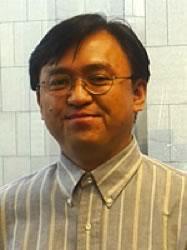The Sakamuro Lab
Daitoku Sakamuro, PhD
Professor, Georgia Cancer Center, Department of Medicine, Medical College of Georgia
Professor, Department of Biochemistry and Molecular Biology
Professor, The Graduate School, Augusta University
Research Summary
The Sakamuro Laboratory is interested in the mechanisms through which cancer cells
acquire resistance to genotoxic stresses and serum starvation. The ultimate goal of
the laboratory is to establish a strategy to enhance the therapeutic benefits of conventional
DNA-damaging chemotherapy in nutrition-starved cancer cells.
Research Interests
BIN1 was originally identified as the c-MYC oncoprotein-interacting adaptor protein
with tumor suppressor properties. BIN1-dependent tumor suppression is unique and attractive,
because BIN1 broadly counteracts the oncogenic transformation mediated not only by
c-MYC, but also human papillomavirus oncoprotein E7 and dominant negative (i.e., oncogenic) mutant of TP53. Furthermore, the highly coiled-coil domain of BIN1 is necessary
and sufficient to inhibit tumor cell proliferation4, and heterologous expression of BIN1 induces apoptosis only in transformed cells.
The BIN1 gene transcription is robustly increased following DNA damage, implying that BIN1
is involved in cellular responses to DNA damage. Consistent with this, BIN1 interacted
with the DNA-repair-priming enzyme poly(ADP-ribose) polymerase 1 (PARP1) and inhibited
its catalytic activity. Accordingly, BIN1 acted as an inducer of genomic instability
and rendered cancer cells sensitive to chemotherapy. The Sakamuro laboratory also
found that oncogenic c-MYC directly suppresses the BIN1 gene transcription in the presence of the MYC-interacting zinc finger protein 1 (MIZ1).
As expected, treatments of chemoresistant cancer cells with 10058-F4 (the small molecule
c-MYC inhibitor) released endogenous BIN1 expression and robustly increased the sensitivity to cisplatin. They will explore
whether PARP1 is the only BIN1 target to inhibit when BIN1 increases genomic instability.
The transcription factor E2F1 induces apoptosis after DNA damage and serum starvation.
In response to DNA damage, E2F1 is phosphorylated by ataxia telangiectasia-mutated
(ATM) kinase to promote apoptosis. However, precisely how serum starvation stimulates
E2F1-induced apoptosis was unclear. The Sakamuro laboratory found that PARP1 interacts
directly with E2F1, increases E2F1 transactivation, and induces G2/M cell-cycle arrest under optimal conditions. In contrast, inhibition of PARP1 enhanced
E2F1-induced apoptosis in serum-starved cells. Interestingly, basal PARP1 activity
modified E2F1 by poly(ADP-ribosyl)ation, which stabilized the interaction between
E2F1 and BIN1 in the nucleus. When the BIN1–E2F1 interaction was abolished by PARP1
inhibition, E2F1 continuously increased BIN1 levels. They also found that serum starvation
massively reduced the E2F1 poly(ADP-ribosyl)ation. These results suggest that the
release of BIN1 from hypo-poly(ADP-ribosyl)ated E2F1 is a mechanism by which serum
starvation promotes E2F1-induced apoptosis. In the vein of hypoxia, serum starvation
generally arises in compacted cancer tissues, particularly after chemotherapy and
anti-angiogenic therapy. Restoration of the sensitivity to serum-starvation-induced
apoptosis may improve chemotherapeutic benefits in late-stage (i.e., chemo- and radiation-resistant) cancer cells.
Selected Publications
Sakamuro D, Prendergast GC. (1999) New Myc-interacting proteins: a second Myc network emerges. Oncogene.18:2942-54. Review
Elliott K, Sakamuro D, Basu A, Du W, Wunner W, Staller P, Gaubatz S, Zhang H, Prochownik
E, Eilers M, Prendergast GC. (1999) Bin1 functionally interacts with Myc and inhibits cell proliferation via multiple
mechanisms. Oncogene. 18:3564-73.
Kinney EL, Tanida S, Rodrigue AA, Johnson JK, Tompkins VS, Sakamuro D. (2008) Adenovirus E1A oncoprotein liberates c-Myc activity to promote cell proliferation
through abating Bin1 expression via an Rb/E2F1-dependent mechanism. J Cell Physiol. 216:621-31.
Lundgaard GL, Daniels NE, Pyndiah S, Cassimere EK, Ahmed KM, Rodrigue A, Kihara D,
Post CB, Sakamuro D. (2011) Identification of a novel effector domain of BIN1 for cancer suppression. J Cell Biochem. 112:2992-3001.
DuHadaway JB, Sakamuro D, Ewert DL, Prendergast GC. (2001) Bin1 mediates apoptosis by c-Myc in transformed primary cells. Cancer Res.61:3151-6.
Research Team

